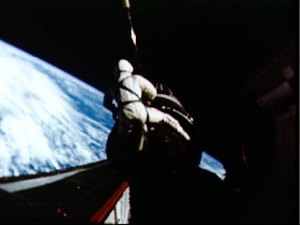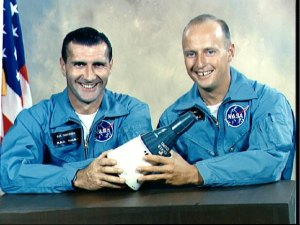 With the exception of Apollo flights, manned spaceflight has operated exclusively in low Earth orbit, the area in space that extends up to about 1,300 vertical miles. In 1966, the Gemini XI crew set an as-of-yet unbroken altitude record within low Earth orbital flights. Using the Agena’s engine, Pete Conrad and Dick Gordon reached an apogee (peak distance from the Earth) of 850 miles; most Gemini missions, and missions since, have operated under the 200 mile altitude. (Left, Dick Gordon during an EVA. 1966.)
With the exception of Apollo flights, manned spaceflight has operated exclusively in low Earth orbit, the area in space that extends up to about 1,300 vertical miles. In 1966, the Gemini XI crew set an as-of-yet unbroken altitude record within low Earth orbital flights. Using the Agena’s engine, Pete Conrad and Dick Gordon reached an apogee (peak distance from the Earth) of 850 miles; most Gemini missions, and missions since, have operated under the 200 mile altitude. (Left, Dick Gordon during an EVA. 1966.)
So why did Gemini XI get to fly higher than any other mission? In short, because Conrad wanted to.
As early as 1961, NASA was tentatively considering going to the moon with a Gemini spacecraft. Proposed missions varied from circumlunar flight and flybys, to stays in orbit, to Gemini lunar landings with modified spacecraft.
 Pete Conrad heard about these daring proposals in the mid-1960s when he was training for Gemini V; he was the pilot on the mission with Mercury veteran Gordon Cooper as his commander.
Pete Conrad heard about these daring proposals in the mid-1960s when he was training for Gemini V; he was the pilot on the mission with Mercury veteran Gordon Cooper as his commander.
Conrad was so interested in pushing the limits of Gemini towards the moon that he went to Congress to seek support for a lunar Gemini mission. He lost; as was typical during the space race, Apollo took priority over just about everything. By the time Conrad was named commander of Gemini XI, there was no chance to take Gemini out of Earth orbit. (Above, Gordon and Conrad, the prime crew for Gemini XI.)
But there was still a chance to push Gemini. Conrad proposed that he and Gordon use their Agena docking vehicle to increase the heigh of their orbit. It wouldn’t be the moon, but it would be something new. He also proposed they dock with the Agena on their first orbit to simulate the timeframe of a lunar orbit rendezvous; previous missions had established their own orbits before chasing down the Agena.
 With the help of fellow astronaut and nuclear engineer Bill Anders, Conrad proved a high orbital Gemini mission would pose no greater risk from radiation than any other mission. He was given a ‘go’ for a record altitude flight. Conrad and Gordon achieved their ambitious goals; the Gemini XI patch points to their ambitious mission. (Left, another shot of Gordon during an EVA.)
With the help of fellow astronaut and nuclear engineer Bill Anders, Conrad proved a high orbital Gemini mission would pose no greater risk from radiation than any other mission. He was given a ‘go’ for a record altitude flight. Conrad and Gordon achieved their ambitious goals; the Gemini XI patch points to their ambitious mission. (Left, another shot of Gordon during an EVA.)
As for the plan to take Gemini to the moon, it was a proposal that appeared sporadically and in different forms throughout the Gemini spacecraft’s lifetime. It’s also something deserving of its own, longer treatment. Look for an article about one proposal over the next few days.


Interesting article, thank you.
Three side notes on this:
Many in NASA were fidgety about this 850-mile apogee. Conrad wanted to stay in this orbit for awhile, but mission control insisted one was enough.
Bill Anders was one of three astronauts to fly on Apollo 8, which trashed the old 850-mile record. Not many people know that mission was originally slated for a high orbit (4,000-mile apogee) before they decided to take the big step to lunar orbit.
Dick Gordon was in line to be Apollo 18 commander, had they not cancelled that mission. He would have joined Lovell and Cernan as the only explorers to make it to the moon twice.
Todd
How long did it take for one orbit at that distance from the earth?
Hi Todd. I believe that there are three who made it to the Moon twice: Lovell, Cernan, and John Young (Apollo 10 and 16).
Great blogging Amy. I’m continually recalling the memories of those missions.